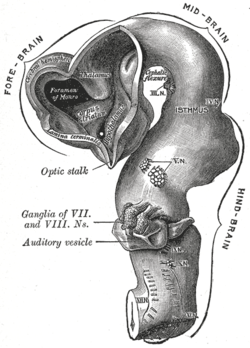| Revision as of 15:50, 16 January 2007 editRmky87 (talk | contribs)Extended confirmed users16,215 editsm restubbed← Previous edit | Revision as of 00:28, 13 August 2007 edit undoArcadian (talk | contribs)163,050 edits {{Development of nervous system}}Next edit → | ||
| Line 31: | Line 31: | ||
| {{developmental-biology-stub}} | {{developmental-biology-stub}} | ||
| {{Gray's}} | {{Gray's}} | ||
| {{Development of nervous system}} | |||
| {{Embryology}} | |||
| ] | ] | ||
Revision as of 00:28, 13 August 2007
| Cephalic flexure | |
|---|---|
 Brain of human embryo of four and a half weeks, showing interior of fore-brain. (Cephalic flexure visible at center top.) Brain of human embryo of four and a half weeks, showing interior of fore-brain. (Cephalic flexure visible at center top.) | |
| Anatomical terminology[edit on Wikidata] |
The cephalic flexure is the first flexure, or bend, of the embryonic brain; it appears in the region of the mid-brain.
By means of it the fore-brain is bent in a ventral direction around the anterior end of the notochord and fore-gut, with the result that the floor of the fore-brain comes to lie almost parallel with that of the hind-brain.
This flexure causes the mid-brain to become, for a time, the most prominent part of the brain, since its dorsal surface corresponds with the convexity of the curve.
External links
- Embryology at UNSW wwwpig/pigg/G7L
- Overview at nlm.nih.gov - online book
- Diagram at nlm.nih.gov - online book
This developmental biology article is a stub. You can help Misplaced Pages by expanding it. |
![]() This article incorporates text in the public domain from the 20th edition of Gray's Anatomy (1918)
This article incorporates text in the public domain from the 20th edition of Gray's Anatomy (1918)
| Development of the nervous system | |||||||
|---|---|---|---|---|---|---|---|
| Neurogenesis |
| ||||||
| Eye | |||||||
| Ear | |||||||